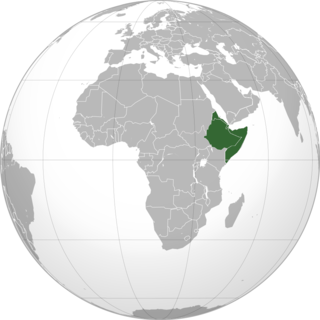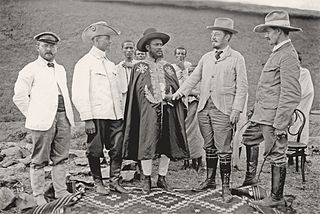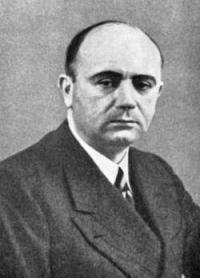Telecommunications in Ethiopia is a monopoly in the control of Ethio Telecom, formerly the Ethiopian Telecommunications Corporation (ETC). As of 2012, 20.524 million cellular phones and 797,500 main line phones were in use.

Many historians trace modern Ethiopia's foreign policy to the reign of Emperor Tewodros II, whose primary concerns were the security of Ethiopia's traditional borders, obtaining technology from Europe, and to a lesser degree Ethiopian rights to the monastery of Dar-es-Sultan in the city of Jerusalem. Tewodros' diplomatic efforts, however, ended disastrously with the British expedition of 1868 which concluded with his death. Despite the efforts of his successor Emperor Yohannes IV to establish a relationship with the United Kingdom, Ethiopia was ignored by the world powers until the opening of the Suez Canal, and more important, the Mahdist War, drew outside attention to her once more.
Tigre, better known in Eritrea by its autonym Tigrayit (ትግራይት), and also known by speakers in Sudan as al-ḫāṣiyyah, is an Afroasiatic language spoken in the Horn of Africa. It belongs to the North Ethiopic subdivision of the South Semitic languages and is primarily spoken by the Tigre people in Eritrea. Along with Tigrinya, it is believed to be the most closely related living language to Ge'ez, which is still in use as the liturgical language of the Ethiopian Orthodox Tewahedo Church and Eritrean Orthodox Tewahedo Church. Tigre has lexical similarity, 71% with Ge’ez and 64% with Tigrinya. As of 1997, Tigre was spoken by approximately 800,000 Tigre people in Eritrea. The Tigre mainly inhabit western Eritrea, though they also reside in the northern highlands of Eritrea and its extension into the adjacent part of Sudan, as well as Eritrea's Red Sea coast north of Zula.

Badme is a town in the Gash-Barka region of Eritrea. Control of the town was at the centre of the Eritrean–Ethiopian border conflict, which lasted from the end of the Eritrean–Ethiopian War in 1998 to the signing of a joint statement at the Eritrea–Ethiopia summit in 2018, 20 years after the conflict started.

Afewerk Tekle was an Ethiopian artist, particularly known for his paintings on African and Christian themes as well as his stained glass.
The Kingdom of Kaffa was an early modern state located in what is now Ethiopia, with its first capital at Bonga. The Gojeb River formed its northern border, beyond which lay the Gibe kingdoms; to the east the territory of the Konta and Kullo peoples lay between Kaffa and the Omo River; to the south numerous subgroups of the Gimira people, and to the west lay the Majangir people. The native language, also known as Kaffa, is one of the Omotic group of languages.

Afäwarq Gäbrä Iyäsus was an Ethiopian writer, who wrote the first novel in Amharic, Ləbb Wälläd Tarik, . Bahru Zewde writes, "Few people before or after him have demonstrated such superb mastery of the Amharic language. Few have ventured with such ingenuity into the hidden recesses of that language to come out with a wealth of vocabulary and idiom one scarcely thought the language possessed. Afäwarq is nonetheless a controversial figure for having supported the Italians during both the First and Second Italo-Abyssinian Wars.

The National Archives and Library of Ethiopia, located in Addis Ababa, is the national library and archives of the country. The library was inaugurated in 1944 by Emperor Haile Selassie and began service with books donated by the emperor.

Rhamnus prinoides, the shiny-leaf buckthorn, is an African shrub or small tree in the family Rhamnaceae. Commonly referred to as “Gesho” it was first scientifically described by French botanist Charles Louis L'Héritier de Brutelle in 1789.
Richard Keir Pethick Pankhurst OBE was a British academic, founding member of the Institute of Ethiopian Studies, and former professor at the University of Addis Ababa in Ethiopia. His books have been reviewed in scholarly journals, with Edward Ullendorff calling his The Ethiopians as another testimony to his "remarkable diligence and industry in the service of Ethiopian studies". He is known for his research on economic history and socio-cultural studies on Ethiopia.
Yekatit 12 is a date in the Ethiopian calendar, equivalent to 19 February in the Gregorian calendar, which is commonly used to refer to the indiscriminate massacre, known as the Addis Ababa massacre, and imprisonment of Ethiopians by elements of the Italian occupation forces following an attempted assassination of Marshal Rodolfo Graziani, Marchese di Neghelli, Viceroy of Italian East Africa, on 19 February 1937. Marshal Graziani had led the Italian forces to victory over their Ethiopian opponents in the Second Italian invasion of Ethiopia and was supreme governor of Italian East Africa. This was one of the worst atrocities committed by the Italian occupation forces and has been described as the worst massacre in Ethiopian history.

Italian Ethiopia, also known as the Italian Empire of Ethiopia, is the shorthand English name given to the Italian possession in the territory of Ethiopia, obtained by expanding the existing Somali and Eritrean colonies in East Africa of the Kingdom of Italy.
The following is a timeline of the history of the city of Addis Ababa, Oromia Region, Ethiopia.
Taddesse Tamrat (1935–2013) was an Ethiopian historian and scholar of Ethiopian studies. He is best known as the author of Church and State in Ethiopia 1270-1520, a book which has “dominated the field of Ethiopian studies”.

The Arbegnoch were Ethiopian resistance fighters in Italian East Africa from 1936 until 1941. They were known to the Italians as shifta.

The monument to the Lion of Judah is a statue of the Lion of Judah, symbol of Ethiopian Emperors and Ethiopia is located to Addis Ababa.
The Institute of Ethiopian Studies(IES) was officially established in 1963 to collect information on Ethiopian civilization, its history, cultures, and languages. The Institute includes a research and publication unit, a library, and a museum. It is located at Addis Ababa University, Sidist (6) Kilo campus, which was at the time of the IES's opening, named Haile Selassie I University after the last emperor of Abyssinia.















